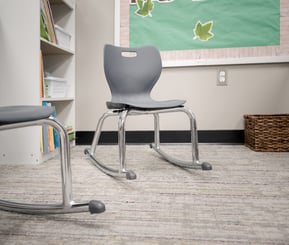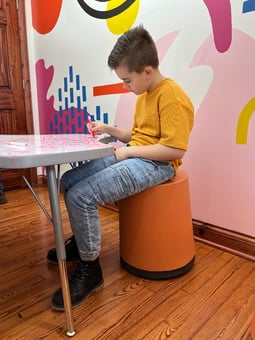can the right furniture help students with physical, emotional challenges
Addressing the diverse needs of every student within a classroom setting poses a challenge. A team of specialists within the Office of Fresno County Superintendent of Schools has recently initiated an investigation into how particular furniture could contribute to supporting students within the learning environment.
Laura Karle, Physical Therapist, for the Office of Fresno County Superintendent of Schools, wanted to answer this question: What types of flexible seating work best in a learning setting to support some of their most challenged students?
Laura and her team serve students with moderate to severe disabilities, including those with orthopedic needs requiring physical support, as well as sensory-seeking students with high motor levels. Among these students, certain individuals encounter difficulties in maintaining a seated and focused demeanor, resulting in behaviors driven by personal interests, instances of aggression towards peers or staff, and assorted challenges. These students are served in center-based programs and special day classes on district sites. Regardless of a student’s challenge, the team is focused on providing each of the students with a free and appropriate education (FAPE) in the least restrictive environment.
When Laura connected with Artcobell, we were excited at the opportunity to explore alongside her. After a virtual meeting and some brainstorming, we provided Laura with several different flexible seating options. Then she and her team went to work on an informal pilot test.
The team learned throughout the pilot that there were a variety of ways they could use the alternative, flexible seating.
- At a specific learning station with the intended purpose for students to self-select the seating for their needs.
- Use the seating as an incentive to encourage and coach a student to sit and participate in a learning activity.
- Assign the seating to a specific student to regulate their sensory needs.
- Use the seating in different classrooms like autism classrooms and sensory rooms.
- By employing the furniture items across diverse spaces and applications, they achieved considerable success and discovered that a more focused approach yielded optimal results.

A targeted plan for FLEXIBLE seating options
Making the correlation between the activities' purpose, seating choices, and student needs, staff started to delineate the suitable utilization of the diverse seating options.
They concluded that when concentrating on sensory activities geared towards eliciting either a calming or arousal response, students could receive tailored support by assisting them in selecting appropriate seating options. For instance, the use of horizontal linear elements frequently induced a calming effect. The gentle rocking motion provided a soothing influence, aiding students who were either overstimulated or needed assistance in self-regulation. In such cases, the Alphabet or Discover rocking chairs proved to be the preferred seating choice.
One of the most striking examples of the benefit of the rocking chair occurred at a center with a student who refused to sit in any chair. Academic work was nearly impossible because the student’s sensory-seeking behavior interfered with her ability to maintain focus on the presented material. The classroom teachers have been amazed at her ability to remain seated and complete work when in the Discover rocking chair.

Conversely, in situations where a student displayed lethargy or lacked stimulation, seats featuring vertical elements designed to engage the vestibular system proved to be more alerting. These options, such as the MOV stool or rocking soft seating, were often accompanied by vibrant colors.

Logistical challenges for schools trying to meet the needs of NeuroDiverse students
A significant hurdle for Laura's programs lies in the ever-changing requirements of the students and the frequent transitions of classrooms. Convincing schools to invest in or redesign an entire classroom from year to year proves challenging, as students eventually move on, necessitating accommodations for new and diverse needs.
Raising awareness within the school and district administration posed an additional challenge for the team. While the team of specialists working with the students recognized the necessity of academic, clinical, and behavioral goals, addressing the importance of providing furniture to support their sensory requirements was a hurdle. By presenting data showcasing student advancements and attributing them to the combined impact of the instructional program and the supportive learning environment (furniture), the team started to make changes. Laura reports that as a result of the pilot study and the success demonstrated, 29 additional Artcobell seating options have been added to classrooms to the benefit of the students, and that is just the beginning.
FLEXIBLE SEATING Pilots provide experience, feedback, and proof of impact to students
The pilot test of seating helped Laura’s team evaluate a variety of options before making a large purchase. The results of the pilot allowed them to demonstrate impact on a small scale and validated a plan to move forward. What they learned was not a total surprise but solidified their direction and supported the second-hand research they had found.
We thank Laura and her team for allowing Artcobell to be part of this pilot and allowing us to support the learning environment of her students. We look forward to hearing more from her as her program evolves.
Here are links to the Artcobell products featured in the Fresno test
Recent Posts
In part one of our series on thoughtful classroom design, we heard an educator’s perspective on...
In part one of our series on thoughtful classroom design, we heard an educator’s perspective on...